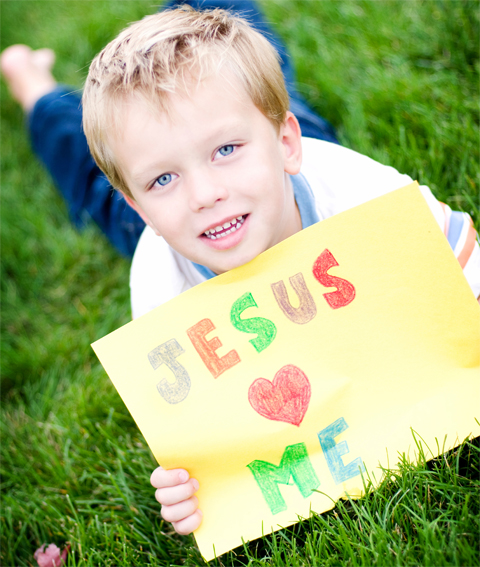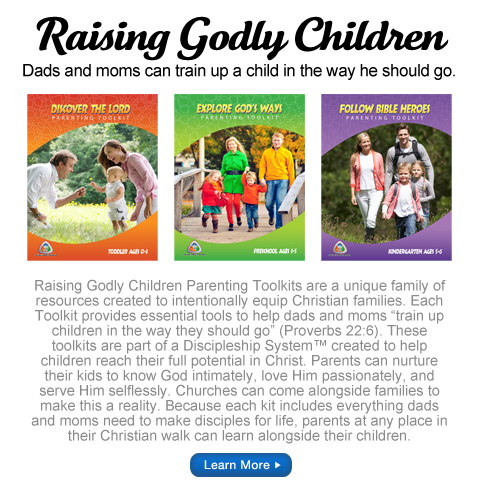(John 14:6, 20:29-31; Matthew 28:18-20)
Jesus answered, “I am the way and the truth and the life. No one comes to the Father except through me.” (John 14:6)
How Kids Think
Children ask, “Is Jesus Christ real?” Some adults honor Jesus as an important historical figure, some worship Him as God, still others reject Jesus and use His name with contempt or indifference. Many children are confused about the Lord’s true identity and don’t know Him as Savior. Kids need guidance and opportunities to learn about Jesus, His purpose on the earth, and how they can know Him personally today.
God’s Wisdom
Though 2000 years have elapsed since He walked the earth, Jesus Christ remains the central figure of human history. Jesus’ messages, miracles, passion, and triumphant resurrection confirm that He is truly God and truly Man, the Savior of the world. Even when society becomes increasingly hostile to the Gospel, the truth remains—Jesus came to seek and to save the lost—redeeming humankind to Himself. Children can embrace Christ as personal Savior, follow Him as Lord, and walk closely with Him each day.
True Story
Denise and all the other teachers had prepared for Easter with extra anticipation and prayer. Children arrived in the classrooms with cute dresses and cleanly pressed shirts. Most came with happy hearts; others had a less-than-perfect morning.
Denise sat down with 15 children and began the lesson with an icebreaker game, a story, and then a video about the Messiah. As the children watched Jesus minister to people, die, and then come back to life, something clicked in little Hannah’s heart. She watched as Jesus miraculously rose from the dead, scoffed at the religious leaders’ attempt to cover up Jesus’ resurrection, and marveled at the realization that Jesus was alive again.
Denise made a simple Gospel presentation, sharing the meaning of Jesus’ sacrifice. Hannah could not stop talking about all the things she would tell Jesus if she could have talked with Him right after He rose from the dead. Hannah firmly grasped the truth about being “made new” (represented by a tasty, green, jelly bean) and having new life. That Easter Sunday, Jesus jumped from the pages of a book and became a real figure in Hannah’s life. She truly believed in Him; He was the One she wanted to follow.
Who is Jesus?
Throughout the Gospel of John, Jesus used word pictures to reveal His identity (light, shepherd, bread, and vine). You can use these same metaphors to explain who He is, what He is like, and what He can do! Find creative ways to show Jesus’ character using the five senses: taste, touch, smell, see, and hear. Use these object lessons below to get started, then enjoy making up your own!
1. Bread of Life (John 6:35). “Jesus replied, “I am the bread of life. Whoever comes to me will never be hungry again. Whoever believes in me will never be thirsty.” (See John 6:25-51 for context.)
Object Lesson: Bring several bread loaves of different shapes and colors (French, rye, banana, wheat, etc.). Label each loaf with a reward that people hope to receive from life (such as money, praise from friends/family, fame, escapes, etc.). Label one loaf “The Bread of Life.” Sample one type of bread at a time. Exclaim how it tastes good, but that in a few seconds you are hungry again. Try the next piece of bread and go through the same process. When you come to the “bread of life,” take a small bite and exclaim how full and satisfied you are. Wait a few seconds, almost grabbing a piece of the other bread because you expect to be hungry—but you are not.
Main point: Read John 6:35. Explain how only Jesus gives life that lasts forever; only He fills our hearts and souls so we are no longer “hungry.” The other loaves of bread did not fill you; they were temporary fixes. Only Jesus gives “bread” that lasts forever.
2. Light of the World (John 8:12). Jesus spoke to the people once more and said, “I am the light of the world. If you follow me, you won’t have to walk in darkness, because you will have the light that leads to life.” (See John 8:12–20 and 9:1–41 for context.)
Object Lesson: Dim the classroom lights (avoid total darkness due to safety hazards and behavior issues). Hide a very bright flashlight beside you. Say to the kids, “Imagine that you are trying to walk around in a very dark place. If you start walking without light, many things could go wrong. You could stub your toe. You could walk into a wall or over the edge of a cliff. You could crash into someone and get hurt. Any smart person knows that when you walk in the dark, you bring a flashlight.” (Turn on the bright flashlight, stand up and shine it before you.) “Now I can see!” Celebrate dramatically as you move through the classroom, avoiding potential dangers (desk, trashcan, walls, etc.) and move around freely without tripping or falling.
Main point: Read John 8:12. Talk about the difference between darkness (sin, separation from God, loneliness, confusion, etc.) and light (joy, peace, salvation, a heart close to Jesus). Just as darkness produces a scary environment where it is hard to see and often hides wrong behavior, light provides peace, warmth, and the ability to see. Jesus is the light for the entire world; He saves us from having to walk in darkness!
3. Good Shepherd (John 10:14-15). “I am the good shepherd; I know my sheep and my sheep know me— just as the Father knows me and I know the Father—and I lay down my life for the sheep.” (See John 10:1-18 for context.)
Object Lesson: Use objects in your house or classroom to create areas that parallel the situations described in Psalm 23. Dress up like a shepherd with a robe and a long rod. The children will pretend to be sheep and follow the shepherd through each area.
- Green Pastures: Use soft carpet or soft green blankets for a green pasture.
- Quiet Waters: Bring a small fountain that makes bubbling sounds, cups of drinking water, and blue fabric to represent water.
- Right Path: Create a narrow path with big blocks, masking tape, or structures.
- Shadowy Valley: Create a tunnel using large black plastic bags, rope, chairs, or classroom structures. Make it big enough to walk or crawl through.
As your children (sheep) progress through each area, have a narrator read each line of Psalm 23.
- Read Psalm 23:1-2a as they follow the shepherd to the green area. Have them lie down and pretend to sleep beside the shepherd.
- Read Psalm 23:2b-3a as the children move to the quiet waters; drink a cup of water and sit in silence by the babbling brook.
- Read Psalm 23:3b as the kids follow the shepherd through the meandering right path
- Read Psalm 23:4 as the children go through the shadowy valley close behind the shepherd.
- At the very end, have the shepherd look at the sheep and say, “I love my sheep so much that I would even lay down my life to protect them.” Have the children pretend to go to sleep while the shepherd stands guard.
Main point: Read John 10:14-15. Remind the kids that Jesus is the Good Shepherd. He protects His sheep, feeds them, gives them peace, and is willing to lay down His life for them.
More Ideas for Sharing Jesus
Help your kids understand that Jesus is the key to having a true relationship with God. He invites everyone into a personal relationship with Him.
Read through the Gospel accounts together. Focus on Jesus’ great love for people; talk about what He says and does. Help your child develop a fuller appreciation of who Jesus is.
Make a personal commitment to follow Jesus Christ. Choose to follow Him everywhere He leads. Free Download: “Good News for Kids” handout.
Unpack Jesus’ role in the trinity. As you read through John 14-17, note how the Father, the Son, and the Holy Spirit relate differently (yet cooperatively) to individual believers.
Share your friendship with Jesus. You are a key role model to show children how to relate to God. Share personal stories about putting your faith in and following Jesus.
__
Discipleship Begins With Our Children
Children need meaningful, shared-life relationships. That’s the heart of discipleship. DiscipleLand’s family of Biblical resources forms a complete Children’s Discipleship System™ – an intentional, relational, and transformational process designed to help children know God intimately, love Him passionately, and to serve Him selflessly. Click here for your Free Catalog
Learn more by clicking on the following:
• Samples
• Nursery and Toddler
• Preschool
• Kindergarten
• Elementary
• Kids Church
• Midweek
• Free Catalog








